After twelve games, Tottenham Hotspur find themselves with a very respectable 27 points, but there are still signs that things aren’t quite right. Mauricio Pochettino’s time at White Hart La… Wembl… soon to be “Tottenham Hotspur Stadium” has been associated with continual improvement. Though last season’s points total couldn’t match 2016/17, the performances were arguably even better, with Harry Kane’s nuclear form fuelling a terrific all around side. Things started stalling towards the end, though, with the expected goals trendline showing a significant decline in the final stretch of last season that has yet to be reversed this term. 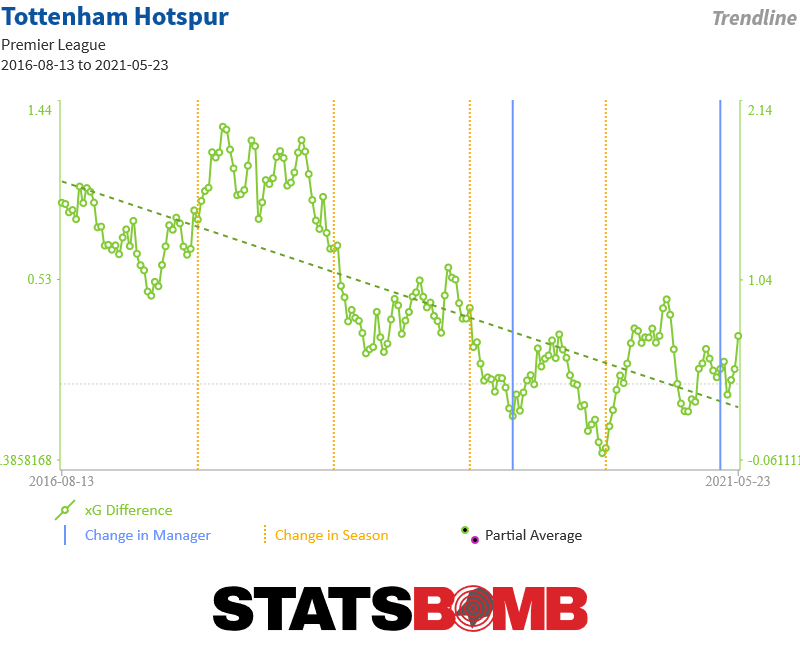 Last season, Spurs generated an xG difference per game of 0.82. This year, it’s down to 0.33. Tottenham are a half a goal per game worse than last year. What perhaps makes it even worse is that this drop off has been split fairly evenly between the attack and defence, so the answer is not simply to change on one side of the ball. As such, the both issues need to be examined. The central stylistic shift that can be seen in the data is that the Spurs press has dropped off significantly. Last season, StatsBomb’s high press rating put Spurs behind only Manchester City. This time, Tottenham’s high press is below average. This shouldn’t automatically be understood as a bad thing, but merely a change in style. While teams that aggressively press high will look to generate a high volume of shots and concede very few, sides that are more conservative here should be making it up in terms of quality, limiting the opposition to longer range efforts and carving out better, if fewer, chances themselves. And this is indeed what we are seeing in an attacking sense, with Spurs’ xG per shot rising from 0.10 to 0.11. The problem is that this improvement in quality hasn’t been nearly enough to balance out the decline in quantity, with Tottenham taking over 4 fewer shots per 90 than last season. Defensively, Spurs can’t even point to a positive in shot quality, with the xG per shot conceded the same figure of 0.09 in both seasons. That is, with the side now conceding 2.3 more shots per 90, rather concerning. This is no longer a side with the kind of data profile we’d expect from a high pressing, shot dominant team. It is not especially obvious whether this is a conscious change in approach from Tottenham or merely a failure to execute the usual style. Hugo Lloris’ comments that Spurs “always try to press the opponent” and “whatever is the score we try to play the same way” would imply that Pochettino has not attempted to make a stylistic shift. But nonetheless, a change has occurred. And, when looking at the defensive activity map, it becomes very clear just how unbalanced Spurs’ pressing is right now:
Last season, Spurs generated an xG difference per game of 0.82. This year, it’s down to 0.33. Tottenham are a half a goal per game worse than last year. What perhaps makes it even worse is that this drop off has been split fairly evenly between the attack and defence, so the answer is not simply to change on one side of the ball. As such, the both issues need to be examined. The central stylistic shift that can be seen in the data is that the Spurs press has dropped off significantly. Last season, StatsBomb’s high press rating put Spurs behind only Manchester City. This time, Tottenham’s high press is below average. This shouldn’t automatically be understood as a bad thing, but merely a change in style. While teams that aggressively press high will look to generate a high volume of shots and concede very few, sides that are more conservative here should be making it up in terms of quality, limiting the opposition to longer range efforts and carving out better, if fewer, chances themselves. And this is indeed what we are seeing in an attacking sense, with Spurs’ xG per shot rising from 0.10 to 0.11. The problem is that this improvement in quality hasn’t been nearly enough to balance out the decline in quantity, with Tottenham taking over 4 fewer shots per 90 than last season. Defensively, Spurs can’t even point to a positive in shot quality, with the xG per shot conceded the same figure of 0.09 in both seasons. That is, with the side now conceding 2.3 more shots per 90, rather concerning. This is no longer a side with the kind of data profile we’d expect from a high pressing, shot dominant team. It is not especially obvious whether this is a conscious change in approach from Tottenham or merely a failure to execute the usual style. Hugo Lloris’ comments that Spurs “always try to press the opponent” and “whatever is the score we try to play the same way” would imply that Pochettino has not attempted to make a stylistic shift. But nonetheless, a change has occurred. And, when looking at the defensive activity map, it becomes very clear just how unbalanced Spurs’ pressing is right now: 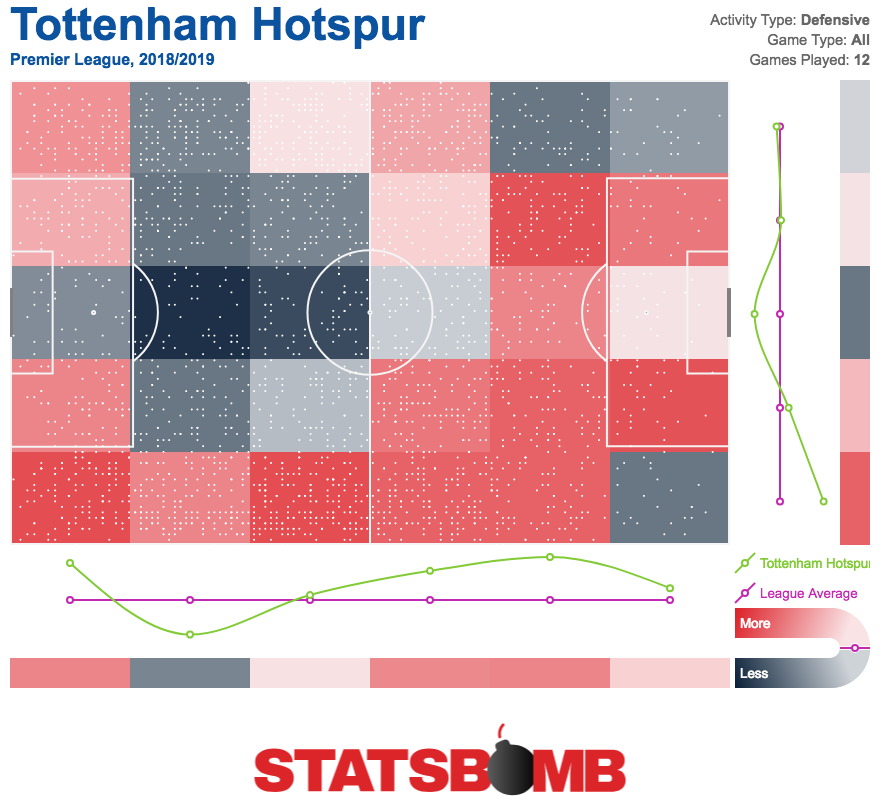 Spurs’ volume of pressing is below average on the left flank and significantly above average on the right. It has been established in the past that Spurs concede an unusually large amount of their chances down the right, so perhaps this is a case of teams targeting that flank and thus there is more defensive work to be done. With Kieran Trippier being such an important attacking cog this season (he easily leads Spurs in open play passes into the box per 90), perhaps his defensive duties have taken a hit. Whatever the cause, when one considers that Spurs’ pressures last season were largely symmetrical, it certainly feels like something isn’t quite right, and the press is dysfunctional as a result. If one were looking for a personnel explanation for the press not functioning as it used to, the player most would likely point toward is Mousa Dembele. The defining mental image of Dembele’s Spurs career has been of him dribbling through a packed midfield, shielding the ball with the opposition seemingly unable to tackle him. This aspect of his game seems to have declined quite drastically. While Dembele completed 2.40 dribbles per 90 last season, this year he is down to just 0.98. Spurs’ way of controlling the midfield has generally relied so much on Dembele’s ability to seemingly be a one man fix for everything, and this isn’t quite happening anymore. Dembele is actually pressuring the ball more than in previous years, but this seems to be just a result of Spurs’ inability to control the midfield as they once did. He is having to do more work without the ball because he cannot dictate the game with it. While a few recent performances looked like he was beginning to find some form again, injury struck once again, and Spurs must hope that Dembele can find something close to his past form in 2019.
Spurs’ volume of pressing is below average on the left flank and significantly above average on the right. It has been established in the past that Spurs concede an unusually large amount of their chances down the right, so perhaps this is a case of teams targeting that flank and thus there is more defensive work to be done. With Kieran Trippier being such an important attacking cog this season (he easily leads Spurs in open play passes into the box per 90), perhaps his defensive duties have taken a hit. Whatever the cause, when one considers that Spurs’ pressures last season were largely symmetrical, it certainly feels like something isn’t quite right, and the press is dysfunctional as a result. If one were looking for a personnel explanation for the press not functioning as it used to, the player most would likely point toward is Mousa Dembele. The defining mental image of Dembele’s Spurs career has been of him dribbling through a packed midfield, shielding the ball with the opposition seemingly unable to tackle him. This aspect of his game seems to have declined quite drastically. While Dembele completed 2.40 dribbles per 90 last season, this year he is down to just 0.98. Spurs’ way of controlling the midfield has generally relied so much on Dembele’s ability to seemingly be a one man fix for everything, and this isn’t quite happening anymore. Dembele is actually pressuring the ball more than in previous years, but this seems to be just a result of Spurs’ inability to control the midfield as they once did. He is having to do more work without the ball because he cannot dictate the game with it. While a few recent performances looked like he was beginning to find some form again, injury struck once again, and Spurs must hope that Dembele can find something close to his past form in 2019.  Dembele’s dip has caused issues for other midfielders. Eric Dier has received some criticism this season, for both his Spurs and England performances, but his traditional midfield partner’s issues can’t be helping. Always more about a fixed role than the “all action” template one associates with English midfielders, Dier is being expected to become more of a two way force to compensate for Dembele, and he doesn’t seem able to do it. Meanwhile, Harry Winks has shown a lot of talent in possession without contributing a lot defensively. Victor Wanyama’s injury issues still persist, and Moussa Sissoko remains Moussa Sissoko. It’s hard not to look at Spurs’ failure to sign a top class central midfielder this summer as a very costly mistake.
Dembele’s dip has caused issues for other midfielders. Eric Dier has received some criticism this season, for both his Spurs and England performances, but his traditional midfield partner’s issues can’t be helping. Always more about a fixed role than the “all action” template one associates with English midfielders, Dier is being expected to become more of a two way force to compensate for Dembele, and he doesn’t seem able to do it. Meanwhile, Harry Winks has shown a lot of talent in possession without contributing a lot defensively. Victor Wanyama’s injury issues still persist, and Moussa Sissoko remains Moussa Sissoko. It’s hard not to look at Spurs’ failure to sign a top class central midfielder this summer as a very costly mistake. 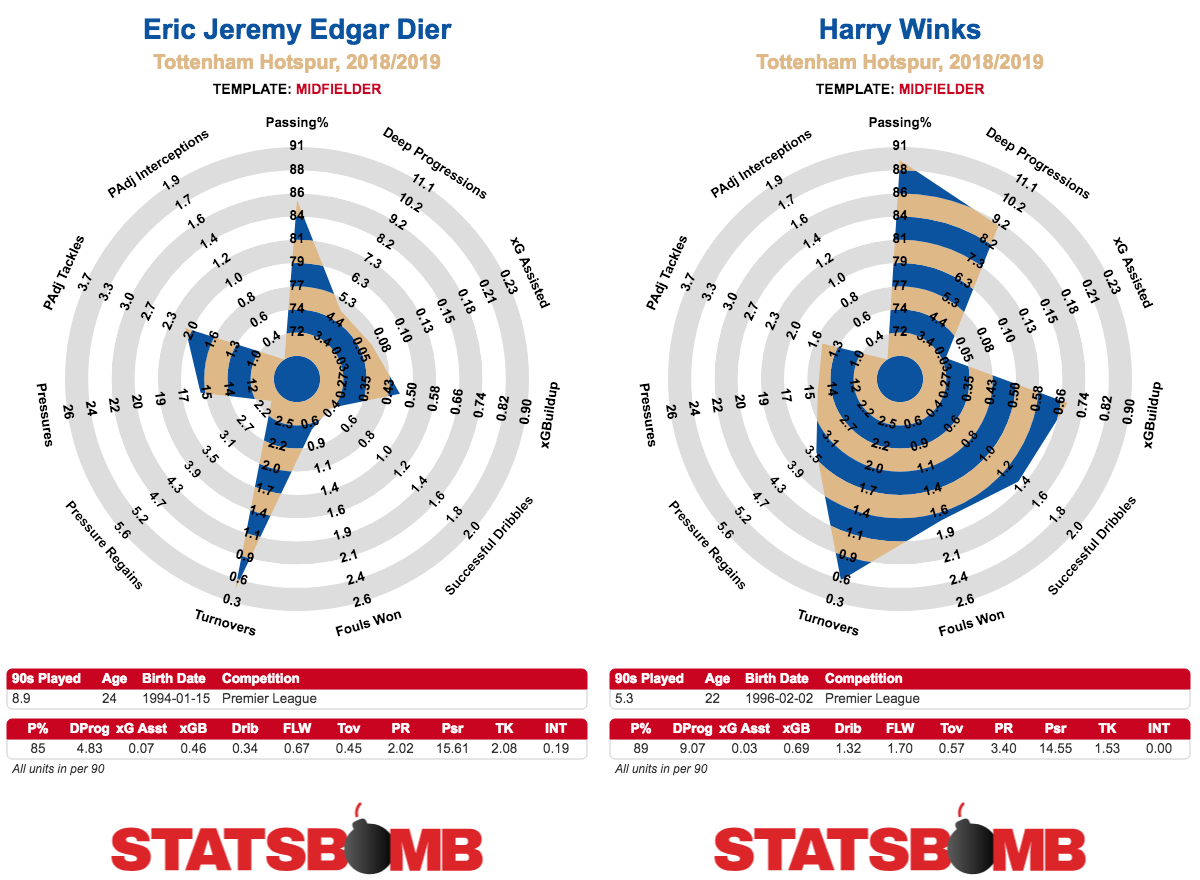 The issues in controlling the midfield seem to have affected players higher up the pitch, too. Dele Alli and Christian Eriksen have been central cogs in this Spurs attack for several years now, with the Alli/Eriksen/Kane axis having been central to the Pochettino era. Possibly due to a lack of security in the midfield and a less well structured press, both have been doing more defending this season, with their defensive output numbers seeing noted increases in the radars below. This seems to have hampered them in their ability to really influence things when in possession. The other factor for an attacking output decline may be the elephant in the room, the striker whose form has not yet been discussed…
The issues in controlling the midfield seem to have affected players higher up the pitch, too. Dele Alli and Christian Eriksen have been central cogs in this Spurs attack for several years now, with the Alli/Eriksen/Kane axis having been central to the Pochettino era. Possibly due to a lack of security in the midfield and a less well structured press, both have been doing more defending this season, with their defensive output numbers seeing noted increases in the radars below. This seems to have hampered them in their ability to really influence things when in possession. The other factor for an attacking output decline may be the elephant in the room, the striker whose form has not yet been discussed… 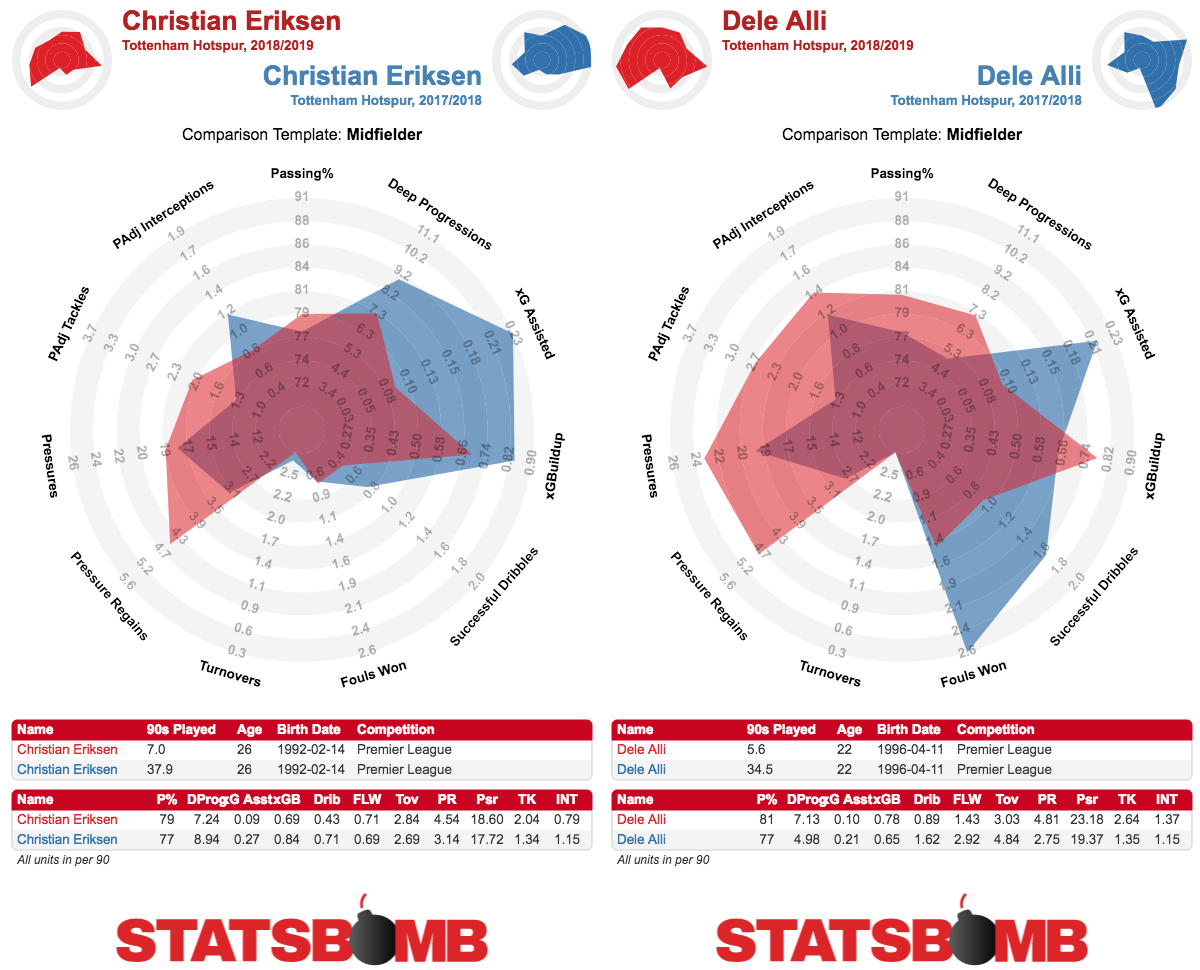 And now, it’s time to talk about the form of a certain Harry Kane. Undoubtedly the driving force behind last season’s attack, there remains a lot of discussion over whether he fully recovered from the injury he received in March. His total goals scored of 6 looks fine, though this is inflated by 2 penalties. The facts remain that his shot volume has dropped significantly while the average quality of the chances he is taking has stayed the same. Many have made the case that Kane seems to be playing a slightly deeper role than last year, and while this may be true, it has not seen a significant rise in his creative work and general play outside the box to compensate for the decline in goalscoring threat. According to StatsBomb’s similarity scores, the Kane of last season most closely resembled Cristiano Ronaldo and Edin Dzeko. This year? Ollie Watkins and Giovanni Sio. Yeah. While he has started in recent times to mix some good performances in with the bad, he is still yet to find any real consistency. The hope is that he is still gradually finding his way back after playing at below 100% fitness, but it is simply that: a hope.
And now, it’s time to talk about the form of a certain Harry Kane. Undoubtedly the driving force behind last season’s attack, there remains a lot of discussion over whether he fully recovered from the injury he received in March. His total goals scored of 6 looks fine, though this is inflated by 2 penalties. The facts remain that his shot volume has dropped significantly while the average quality of the chances he is taking has stayed the same. Many have made the case that Kane seems to be playing a slightly deeper role than last year, and while this may be true, it has not seen a significant rise in his creative work and general play outside the box to compensate for the decline in goalscoring threat. According to StatsBomb’s similarity scores, the Kane of last season most closely resembled Cristiano Ronaldo and Edin Dzeko. This year? Ollie Watkins and Giovanni Sio. Yeah. While he has started in recent times to mix some good performances in with the bad, he is still yet to find any real consistency. The hope is that he is still gradually finding his way back after playing at below 100% fitness, but it is simply that: a hope. 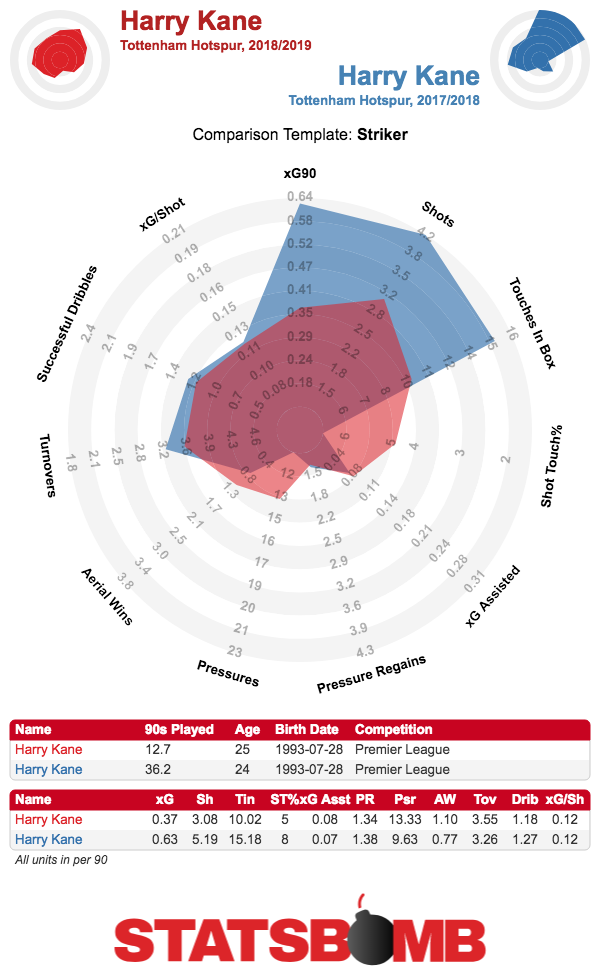 This article has largely focused on the issues with individual players because it does seem like this is the root cause of the problem. There does not appear to have been a huge shift in how Pochettino intends this Spurs team to play, and there is little reason to think that he has suddenly become bad at coaching these players. This is the same group of players with the same manager as 2017/18, but the issues around Kane and Dembele seem to have shaken the foundations of the side. But perhaps that is part of the issue: it is the same side. The desire to get Kane on the pitch as much as humanly possible is an understandable one, considering the alternative striking options are Fernando Llorente and Vincent Janssen. Yes, that’s right, Vincent Janssen. But that these are the other options shows how poorly Spurs have bought strikers in recent years. To find a centre forward they purchased who would be considered a success, one has to go back to Emmanuel Adebayor, and even he only performed in spurts. Similarly, Dembele’s recent struggles have been unfortunate for a side so reliant on him to make them tick. But, as is well publicised, Spurs’ did not manage to sign the central midfielder needed to reinvigorate the team this summer. The core of players that Pochettino has been working with has remained largely static for several years. Of course, these issues are not apocalyptic. While Spurs look a fair bit behind Manchester City, Liverpool and Chelsea, their numbers remain significantly better than Arsenal and Manchester United. A top four finish remains theirs to lose. Pochettino remains a manager more than capable of finding tactical solutions to adjust to some of the personnel issues he has right now. Still, it’s hard to escape the feeling that Spurs have taken a step backwards this season, and we have yet to see evidence that they will be able to reinvigorate the side in the transfer market well.
This article has largely focused on the issues with individual players because it does seem like this is the root cause of the problem. There does not appear to have been a huge shift in how Pochettino intends this Spurs team to play, and there is little reason to think that he has suddenly become bad at coaching these players. This is the same group of players with the same manager as 2017/18, but the issues around Kane and Dembele seem to have shaken the foundations of the side. But perhaps that is part of the issue: it is the same side. The desire to get Kane on the pitch as much as humanly possible is an understandable one, considering the alternative striking options are Fernando Llorente and Vincent Janssen. Yes, that’s right, Vincent Janssen. But that these are the other options shows how poorly Spurs have bought strikers in recent years. To find a centre forward they purchased who would be considered a success, one has to go back to Emmanuel Adebayor, and even he only performed in spurts. Similarly, Dembele’s recent struggles have been unfortunate for a side so reliant on him to make them tick. But, as is well publicised, Spurs’ did not manage to sign the central midfielder needed to reinvigorate the team this summer. The core of players that Pochettino has been working with has remained largely static for several years. Of course, these issues are not apocalyptic. While Spurs look a fair bit behind Manchester City, Liverpool and Chelsea, their numbers remain significantly better than Arsenal and Manchester United. A top four finish remains theirs to lose. Pochettino remains a manager more than capable of finding tactical solutions to adjust to some of the personnel issues he has right now. Still, it’s hard to escape the feeling that Spurs have taken a step backwards this season, and we have yet to see evidence that they will be able to reinvigorate the side in the transfer market well.
2018
What’s Up with Tottenham?
By admin
|
November 23, 2018